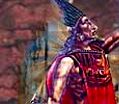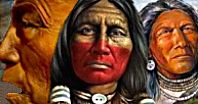|
|  |

Fremont people, ancient indians that lived from 700 to 1300 AD.
 The Fremont
people lived throughout
Utah and adjacent areas of
Idaho,
Colorado and
Nevada from 700 to 1300 AD. The culture was named for the Fremont River
and its valley in which many of the first Fremont sites were discovered. The Fremont
people lived throughout
Utah and adjacent areas of
Idaho,
Colorado and
Nevada from 700 to 1300 AD. The culture was named for the Fremont River
and its valley in which many of the first Fremont sites were discovered.
The Fremont were
a Puebloid group who had strong cultural affiliations with their
better-known contemporaries, the Anasazi. While the
Anasazi built cliff
dwellings, the Fremont often lived in pit houses (dug into the ground and
covered with a brush roof), wickiups (brush and log huts) and natural
rock shelters. Their social structure was composed of small, loosely
organized bands consisting of several families.
 |
The San Rafael swell in southeastern Utah features more than 300 Fremont
rock art sites.
Photo courtesy of
Utah State History. |
They were closely
tied to nature and were flexible, diverse and adaptive. The Fremont people often made
changes in their lifestyles as social or environmental changes occurred.
The Fremont maintained a hunting
and gathering lifestyle and supplemented their diet by farming;
growing corn, beans and squash along the river bottoms. Edible native
plants included pinon nuts, rice grass and a variety of berries,
nuts, bulbs, and tubers. Corn was ground into meal on a stone surface
(metate) using a hand-held grinding stone (mano.) Food was stored in
pottery jars or baskets inside small masonary structures, called
granaries, which were tucked under small overhangs on narrow ledges.
Deer, bighorn sheep, rabbits, birds, fish and rodents were hunted
using snares, nets, fishhooks, bow and arrow, and the atlatl or
throwing stick.
Archeologists have identified several kinds of
artifacts that are distinctive to the Fremont people.
One was a
singular style of basketry, called one-rod-and-bundle, which
incorporated willow, yucca, milkweed, and other native fibers. They
also created pottery, mostly graywares, with smooth, polished surfaces
or corrugated designs pinched into the clay.
Unlike the Anasazi who wore yucca fiber sandals, the Fremont people made
moccasins from the hide of large animals, such as deer, with the dew
claw placed on the sole to act as a hobnail; providing extra traction
on slippery surfaces.
The most unique and mysterious artifacts left by the Fremont people were clay
figurines. The small figures resemble people, often showing intricate
details such as ear bobs, necklaces, clothing, hair and facial
decorations and sexual characteristics. The purpose of figurines is
unknown, but it is believed they had magical or religious
significance.
Fremont figurines
resemble Fremont rock art. Pictographs (painted) and petroglyphs (carved
or pecked) are depictions of people, animals and other shapes and
forms left on rock surfaces. Anthropomorphic (human-like) figures
usually have trapezoidal shaped bodies with arms, legs and fingers.
Don't touch the petroglyphs
The
figures are often elaborately decorated with headdresses, ear bobs,
necklaces, clothing items and facial expressions. A wide variety of
zoomorphic (animal-like) figures include bighorn sheep, deer, dogs, birds,
snakes and lizards. Abstract designs, geometric shapes and handprints are
also common.
Please refrain from any activity that involves touching the panels. The oil on your skin damages the rock paintings.
The meaning of rock art is unknown.
The designs may have recorded
religious or mythological events, migrations, hunting trips, resource
locations, travel routes, celestial information and other important
knowledge. Many believe rock art uses symbolic concepts that provide the
observer with information and that it was important, not not simply
artistic expression or doodling. Some day, we may understand rock art
better, but only if these sites are not destroyed. The slightest touch
removes fine granules of sand and leaves behind a residue of sweat and
oil.
Fremont rock art
and archaeology sites can still be seen in numerous places
Fremont rock art
and archaeology sites can still be seen in numerous places in the
southwest including Utah's Fremont Indian State Park, which protects the
largest Fremont site ever excavated in Utah, including forty pithouses,
twenty granaries and countless artifacts and rock art panels.
More can be seen at Zion, Capitol Reef, and Arches National Parks and at the Dinosaur
National Monument in Colorado.
By
1300 AD, the Fremont had abandoned their villages. Archeologists can't
quite agree on what happened, but several changes are generally blamed. First, climatic
conditions favorable for farming seem to have changed during this period,
forcing local groups to rely more and more on wild food resources and to
adopt the increased mobility necessitated in collecting wild food.
At the same time, new groups of hunter-gatherers appear to have migrated
into the Fremont area from the southwestern Great Basin sometime after
about 1,000 years ago. These full-time hunter-gatherers were apparently
the ancestors of the Numic-speaking Ute, Paiute, and
Shoshoni peoples who
inhabited the region at historic contact, and perhaps they displaced,
replaced, or assimilated the part-time Fremont hunter-gatherers.
SOURCE:
U.S. National Park Service
|
 |


|
|
| | | | | | | | |
 |
|
|

